Understanding Contamination in Selective Mutism: Holiday Edition
The word “contamination” has a variety of meanings both within and outside of the mental health field. This article seeks to clarify the meaning of contamination in regard to selective mutism.
Imagine you just moved into a new house or apartment. As you are unloading your furniture, you see a neighbor—you offer a slight smile and nod, but do not strike up conversation. At this point, there is still plenty of time to greet them later. However, as the months pass and once filled boxes have become more barren, you still have not knocked on the neighbor’s door to introduce yourself. The thought of introducing yourself now leaves you a bit uneasy given the lapse in time. A year later, you find that you have still not introduced yourself—and there is no way you are doing it now!
Contamination in selective mutism is a lot like the neighbor to whom you never introduced yourself. The longer a child goes without verbally interacting with a specific person, the harder it is to break this pattern of behavior. For example, if a teacher has never heard a child speak and does not prompt them for verbal engagement, after a year, the child learns that speaking is not expected. Additionally, the child associates being non-verbal with being in the presence of the teacher, such that they have become “contaminated.” The child may feel that breaking this non-verbal pattern would be especially hard or elicit a strong reaction from the teacher, which children with selective mutism often fear.
Similarly, environments or locations can also become contaminated. For children with selective mutism, school may be viewed as a place where they do not speak. Repeated instances of attending school and not speaking reinforce to the child that this is a “no speaking zone” and further perpetuates selective mutism. In this way, while a child may be talkative and friendly at home, they may be quiet at school, making it important to assess a child’s behavior in all environments.
Furthermore, contamination can occur anywhere and with anyone. However, because extended family members are often present during events such as holidays where the environment (e.g., the number of people) may present more significant challenges for a child to speak, it is not uncommon for people such as grandparents to become contaminated. This trend can be especially difficult for families. So what can you do?
Intervention
First and foremost, it is crucial to remember that “contaminated” individuals are likely the most difficult people for your child to practice their brave voice with. Intervention for selective mutism starts small and grows at the child’s pace. For example, depending on the child’s presentation, they may begin with a “low level” task such as answering a yes or no question from their parents while a therapist is present in the room, then move up in difficulty. If your family has identified an individual who you suspect may be contaminated, gradually introducing your child to other speaking partners should occur before this person is introduced to intervention. Thriving Minds specializes in working with children with selective mutism and offers a variety of services such as therapy and parent consultation.
Holiday Tips
· Set realistic expectations: depending on your child’s presentation, talking to a contaminated individual by the end of the family gathering may not be feasible. Discuss with your child potential brave practices that may be difficult, but that your child is willing to try.
· Use the staircase strategy: start easy and take small steps towards bigger goals. For example, the child may begin the gathering by using their brave voice around others but directed towards a parent, and move toward response tasks such as answering another family member’s question.
· Practice before extended family arrives: the first step on the staircase is to role-play interacting with extended family. Though this may feel silly, it allows the child to familiarize themselves with the goals and expectations.
Whichever “step” on the staircase your child is at, Thriving Minds is here to help. In fact, you have already taken a step by reading this article and advocating for your child’s well-being. For professional support for children with selective mutism, contact any of our offices (Brighton, Chelsea, Livonia, and Grand Rapids). More information regarding contamination in selective mutism can be found in Selective Mutism: An Intervention guide for Therapists, Educators, and Parents, Revised and Updated Edition, written by Aimee Kotrba, Ph.D., and Katelyn Reed, M.S., providers with extensive clinical experience and expertise with selective mutism.

